- Home
- Encyclopedia
- Three Crossings
Three Crossings
Wagon-train emigrants traveling the Oregon Trail along the Sweetwater River in the mid-1800s came to a place called the Narrows, where steep hills close to the river forced the trail to cross it three times within two miles.
Threading the Narrows was not the travelers’ only option, however. Also available was the so-called Deep Sand Route, which stayed south of the river but forced animals to pull wagons through several exhausting miles of deep sand. A stage station, Pony Express station and Army outpost were located here in later years. The spot was a few miles north of present Jeffrey City, Wyo.
Most emigrants used the canyon route unless water levels were too high or, as was the case in some later years, the road was washed out and impassable. As the years passed the place gradually became known as Three Crossings.
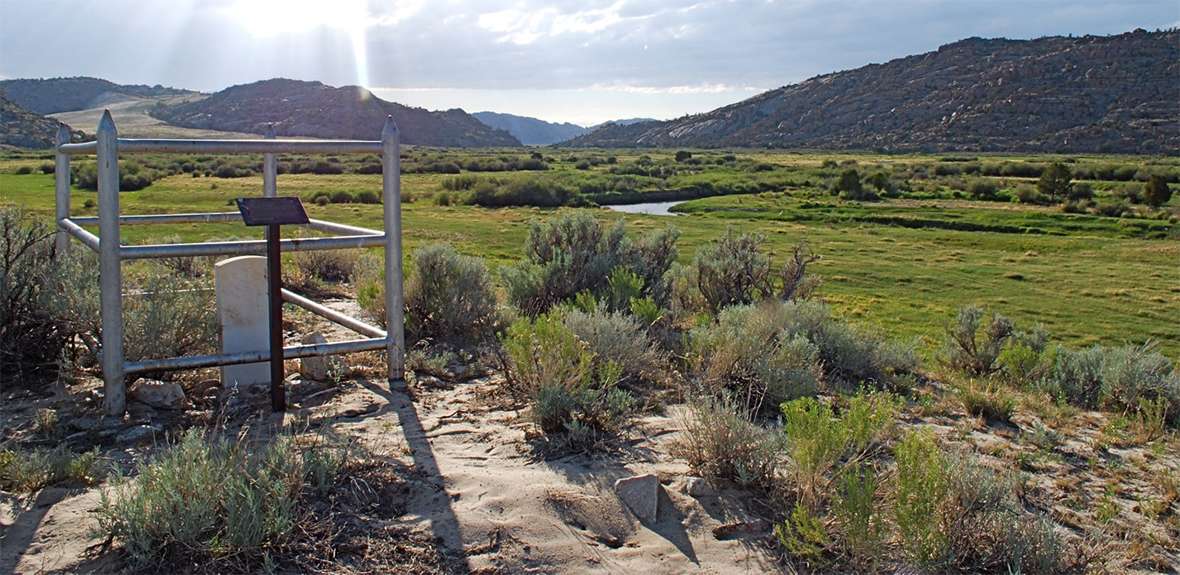
On the north side of the river the hills at one point pressed in so closely there was room for just wagon at a time between the water’s edge and a wall of granite. Here, hundreds of emigrants left their names on the rock, as they had earlier at Independence Rock and Devil’s Gate.
“Some more recording of little names on the granite rock after immediately crossing the ford – done as usual with cart grease,” Joseph Middleton wrote in July 1849, a year when he and many others noted hundreds of names. By the 1850s, diarists counted names in the thousands. Only a few remain.
Travelers who passed in June frequently mentioned high water.
“The crossings were bad and dangerous for wagons,” Isaac Wistar wrote June 28, 1849, “–especially the last [crossing]–where the current and deepest channel were immediately under the near bank, and notwithstanding the many tons of rock thrown in to level up, the mules were swimming from the start, the wagons taking a headlong plunge after them.”
Traffic was especially heavy in the gold-rush years of 1849 and 1850.
“We crossed the river at the first ford,” Alonzo Delano wrote June 25, 1849, “and entered the rocky gorge through which the river flowed, and proceeded about a mile to the second ford. A narrow pathway had been cut on the bank, capable of admitting but one wagon at a time, and the ford was so deep that every wagon box had to be raised about six inches from its bed to prevent the water from flowing in.”
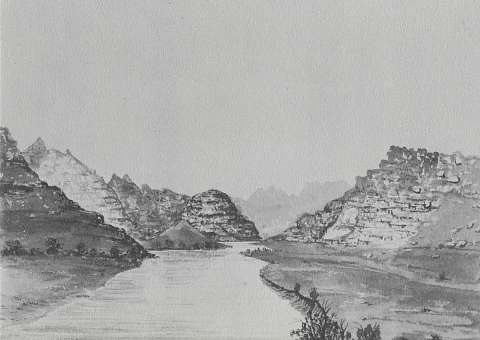
But the ford looked so bad, and there were already so many teams ahead of them waiting to use it, that Delano and his party backtracked and took the Deep Sand Route instead.
That alternative bypassed the so-called Second, Third, Fourth, and Fifth Crossings of the Sweetwater. The first three of the series are the Three Crossings, after which the wagons ended up on the north side of the river and crossed to the south side again eight miles further on at the Fifth Crossing.
The two roads merged again a mile or so west, on the high ground above that point. When Delano and his party reached the junction, after traveling eight miles around the Narrows—four of the miles very sandy—they nevertheless “found ourselves meeting trains which had been a day ahead of us,” he wrote, pleased to have made up time.
The 1850 season saw the heaviest traffic of all. On June 25 of that year, James Evans found the Narrows entirely congested. “There were a train of wagons nearly a mile long; some had mule teams and some had oxen; here for two hours we moved along inch by inch, while the scent of dead cattle was unremitting and utterly obnoxious,” he wrote.
“When the front wagon would move three feet, the whole string of wagons a mile long would close up. No one had room enough in the narrow road to run on ahead to see what was the matter. Those who were riding mules like myself had to keep close to the hind part of some wagon. This was by no means an enviable position, for it so happened that a ‘horned team’”—an ox team—“was just behind me, and when the lash of five hundred whips was sounding in the rear, amid the curses loud and deep, the impatient teams would occupy every inch forward they could; and when the horns of the oxen would tickle the flanks of my frightened mule, he had no room to kick.”
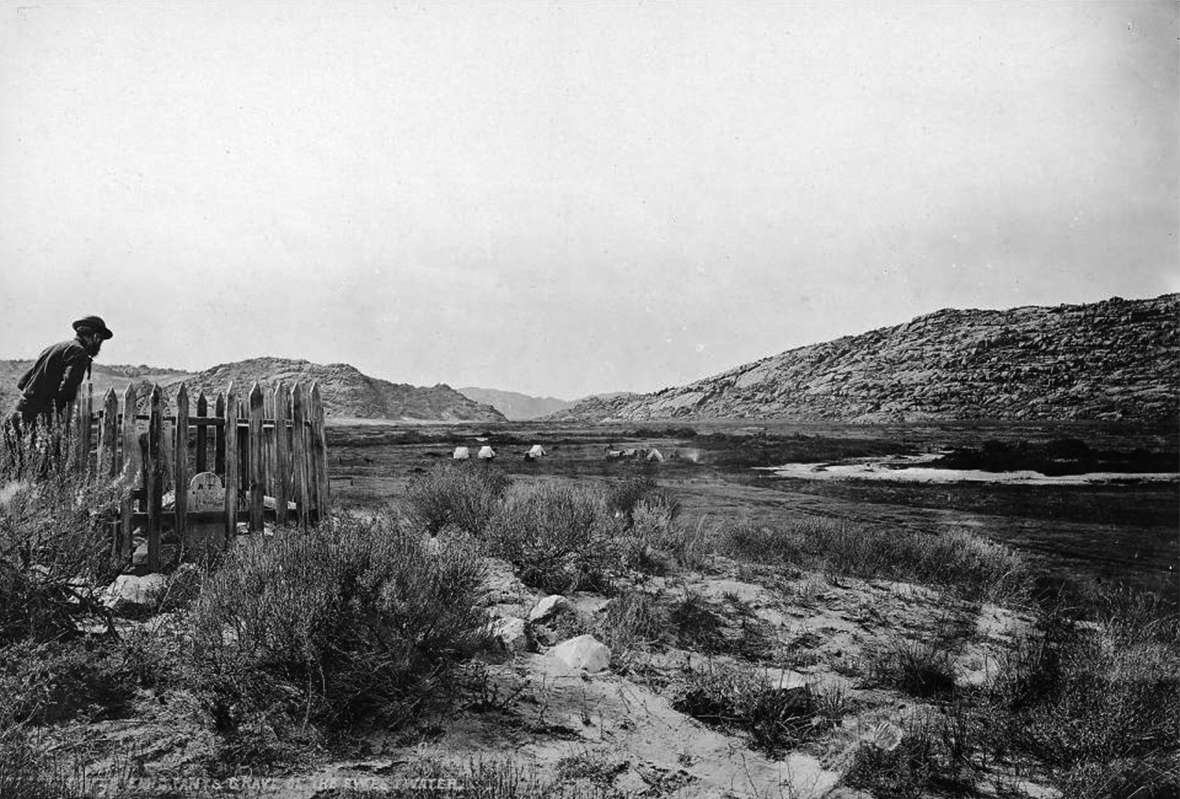
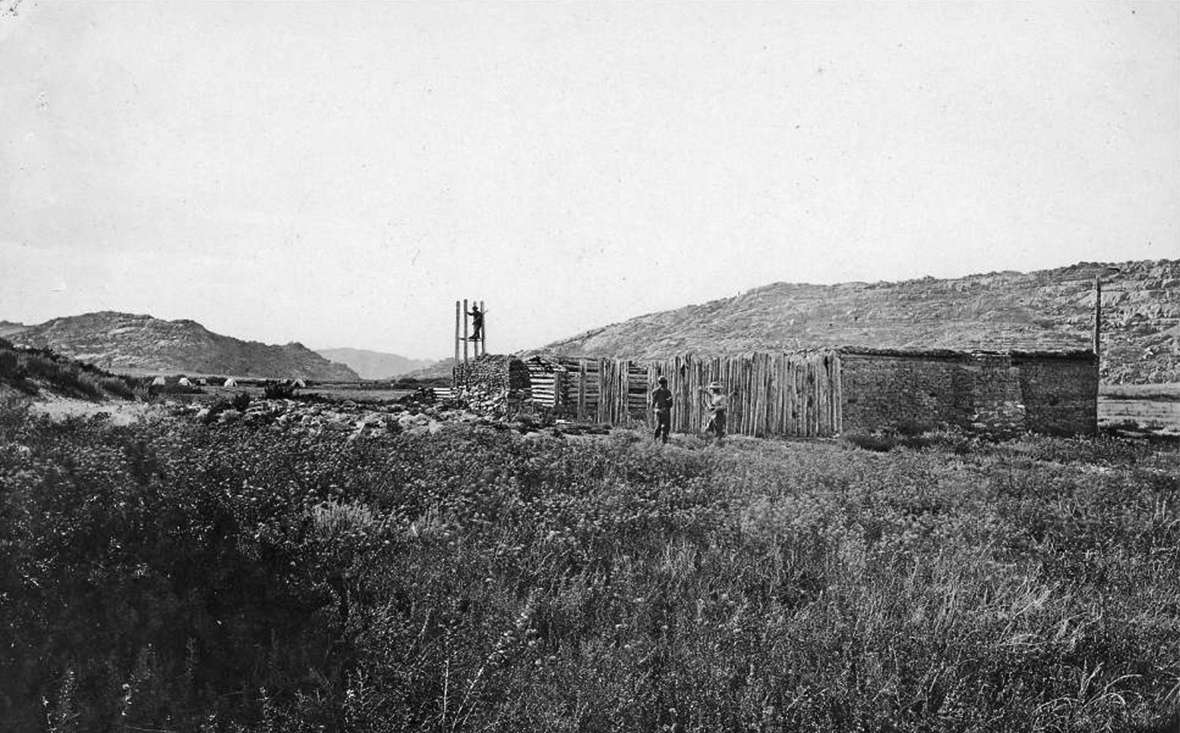
By 1860, when British adventurer and travel writer Richard Burton made the trip in a stage coach, he was pleased to report that something like what he considered civilization had arrived ahead of him. “At 11 A.M. we reached ‘three crossings,’” he wrote Aug. 19, 1860, “when we found the ‘miss,’ a stout, active, middle-aged matron, deserving of all the praises that had so liberally been bestowed upon her.”
“The little ranch,” Burton continued, meaning a road ranch, probably a low cabin with a dirt roof, “was neatly swept and garnished, papered and ornamented. The skull of a full-grown Bighorn hanging over the doorway represented the spoils of a stag of twelve. The table cloth was clean, so was the cooking, so were the children; and I was reminded of Europe by the way in which she insisted upon washing my shirt, an operation which, after leaving the Missouri, ça va sans dire, [it goes without saying] had fallen to my own lot.”
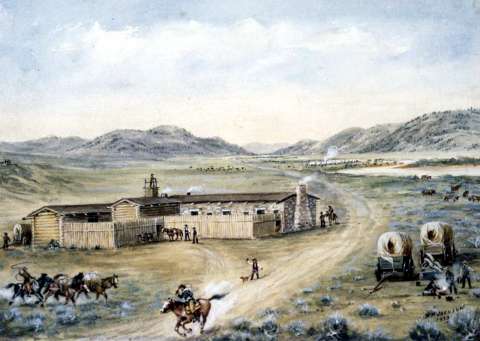
When Lucia Darling, bound from Tallmadge, Ohio, to the gold fields of western Montana, passed with a party in August 1863, they were pleased to find a troop of Ohio cavalry at the outpost near the former stage and Pony Express station. “Some of the company climbed to the top of a high rocky steep cliff and as we looked at them from camp they looked like insects crawling up the side and when they reached the top, looked still smaller against the white sky,” she wrote.
One soldier, at least, made a good impression. “The Captain of the station came out to meet us and went with us to camp, staying until evening. He is an Ohio man and expects to return to his family there when his time expires. We liked him very much and we all had a good sing, Mr. Everhart accompanying us on the violin.”
Resources
Primary Sources
- Burton, Richard F. The City of the Saints and across the Rocky Mountains to California [1860]. London, UK: Longman, Green, Longman, and Roberts, 1861. American edition, New York, N.Y: Harper & Brothers, Publishers, 1862. Reprinted as The Look of the West, Overland to California, University of Nebraska Press, 1963.
- Darling, Lucia A. Diary of a Trip Across the Plains from Tallmadge, Ohio, to Bannack City, 1863. Lucia Darling Collection, Montana Historical Society.
- Delano, Alonzo. Life on the Plains and among the Diggings. Auburn, N.Y: Miller, Orton & Mulligan, 1854. Reprinted New York, NY, Wilson-Erikson, 1936.
- Evans, James William. Trip to California Across the Plains in the Year 1850. MSS C-F 80, Bancroft Library. Richard Rieck transcription.
- Middleton, Joseph. The Diary and Letters of Dr. Joseph Middleton: Joseph Middleton Papers. MSS S-39, Beinecke Library. Richard L. Rieck transcription.
- Wilkins, James F. An Artist on the Overland Trail: The 1849 Diary and Sketches of James F. Wilkins. Ed. by John Francis McDermott. San Marino, Calif: The Huntington Library, 1968.
- Wistar, Isaac Jones. Diary in Autobiography of Isaac Jones Wistar, 1827–1905: Half a Century of Peace and War. Philadelphia, Penn: The Wistar Institute of Anatomy and Biology, 1937.
Secondary sources
- Brown, Randy. Oregon-California Trails Association. WyoHistory.org offers special thanks to this historian for providing the diary entries used in this article.
- Wyoming State Historic Preservation Office. “Three Crossings Canyon.” Emigrant Trails Throughout Wyoming. Accessed March 2, 2017, at http://wyoshpo.state.wy.us/trailsdemo/threecrossings.htm.
Illustrations
- Wilkins’ watercolor sketch is from his book, An Artist on the Overland Trail: The 1849 Diary and Sketches of James F. Wilkins. Ed. by John Francis McDermott. San Marino, Calif: The Huntington Library, 1968.
- The two 1870 William Henry Jackson photos are from the Tom Perry collection, Harold B. Lee Library, Brigham Young University. Used with thanks.
- The 1933 Jackson painting is from the William Henry Jackson Collection at Scotts Bluff National Monument. Used with thanks.
- The color photo of the Trippett grave, with the Narrows in the background, is by Randy Brown. Used with permission and thanks.
